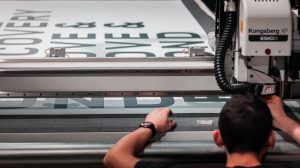Pushing “print” on a big job is always a little nerve-racking. Have you dotted all the “i’s” and crossed all the “t’s?” Is there a typo? An incorrect size? An incorrect file? Is there enough bleed? Will you get it to the printer in time to be distributed before the big sale or event? Relax—we have you covered! Here’s what you’ll need to know for a perfectly timed, perfectly printed job, every time.
First, the Format
One of the easiest ways to get tripped up before printing is by creating your piece in the wrong file format. You’ll end up with incompatible files that the printer can’t use—or worse, blurry photos or pixelated graphics that your customer can’t use. Save yourself those headaches with this handy chart, which outlines the file types that are preferred when you’re printing out different types of pieces:
|
File Format |
Images/Graphics (Includes Artwork/Illustrations/ Typography) |
Logos |
Photos |
Outdoor |
Print Documents |
|
.ai |
✓ |
✓ |
|
✓ |
✓ |
|
.eps |
✓ |
✓ |
✓ | ||
|
.jpg or .jpeg |
✓ | ||||
|
|
✓ |
✓ |
✓ | ||
|
.psd |
✓ | ||||
|
.tif or .tiff |
✓ |
Second, Resolution and File Sizes
These next two items are straightforward. Make sure that your image resolution is sharp. We recommend a 300 (or higher) DPI image for maximum quality on most jobs. However, for print jobs viewed at a distance (like a billboard or truck), the resolution does not need to be as sharp, so the large format may be 100 DPI at actual size. Check your file size too to keep it manageable. Higher resolution = larger file size, so speak with your print partner to determine the best resolution for each specific job.
Related: DPI and Resolution for Different Media
This is just a guideline, but the loose file size requirements for high-quality files are:
- A file < 250 KB is only good on screen.
- 250 KB-500 KB images can work as thumbnails.
- 500 KB-1 MB is good for one eighth of letter size (8.5” x 11”).
- 1 MB-1.5 MB is good for one quarter of letter size.
- 1.5 MB-2 MB is good for half of letter size.
- 3.5 MB is good for letter size.
- 6 MB+ is good for tabloids (11” x 17”) and more.
The Ultimate Print Checklist: Check It Before You Send It
So that you don’t miss a detail, use this checklist to make sure that your file has exactly what your printer needs:
- Make sure that you choose a file format that lines up with the correct type of print piece from the chart above.
- Ask your printer if they’d like file images sent in their own files or if they’d prefer the images be embedded in the applications.
- You can never proofread your file too much. Run it past several sets of eyes. Read the copy out loud. Check the colors too. You want it perfect before you print it.
- Don’t forget the fonts! Letting your printer know which font you’re using saves any potential font-based faux pas. Check to see if your fonts are in a compatible format like postscript type 1, and ensure they are not corrupt.
- Check the resolution for all images. This is extremely important to ensure that you don’t get grainy images. Make sure that all images are saved at the correct DPI and you have the highest quality possible for your file.
- Ensure that it’s CMYK (NOT RGB) color in order to achieve the correct color separation. Also be sure to LOOK at the color separations.
- Check for bleed and crop marks around the edges.
- Does the document size match the trim size? If not, make sure it does.
- Check to see if your piece is set up for imposition or multi-page design.
- Make sure that your fold lines match accepted folding styles.
Related: Our Pre-Press Checklist
It’s Go Time: How and When to Send Files to Your Printer
Once you’ve nailed the above steps, you’re ready to ship to your printer. Since each printer has their own system for sending, check their preference first. They’ll likely tell you to:
- Upload to an FTP Server: They’ll send you a link to their secure, password-protected site, and you can hit the “upload” button to send files along.
- Upload to a Cloud Storage Service: You’re probably familiar with sites like Dropbox, OneDrive and Google Drive. These are also safe and easy ways to send files to your printer. Just upload them here.
- Send Through Email: Although email is not as secure as the above options, it’s definitely easy. And with smaller files, it’s a quick way to get your pieces to your printer.
Now you’re ready to roll through the presses. And for an unabridged version of all things pre-press, download our guide, “Print Like a Pro.” Keep these resources handy for every print job. You can be confident hitting “send” again and again (and your printer will thank you too)!




